Your Cart is Empty
Customer Testimonials
-
"Great customer service. The folks at Novedge were super helpful in navigating a somewhat complicated order including software upgrades and serial numbers in various stages of inactivity. They were friendly and helpful throughout the process.."
Ruben Ruckmark
"Quick & very helpful. We have been using Novedge for years and are very happy with their quick service when we need to make a purchase and excellent support resolving any issues."
Will Woodson
"Scott is the best. He reminds me about subscriptions dates, guides me in the correct direction for updates. He always responds promptly to me. He is literally the reason I continue to work with Novedge and will do so in the future."
Edward Mchugh
"Calvin Lok is “the man”. After my purchase of Sketchup 2021, he called me and provided step-by-step instructions to ease me through difficulties I was having with the setup of my new software."
Mike Borzage
Seamless Integration of Additive Manufacturing Within CAD Systems: Enhancing Design Flexibility and Workflow Efficiency
November 24, 2024 8 min read


Additive manufacturing (AM), commonly known as 3D printing, has revolutionized the landscape of modern design and production. By constructing objects layer by layer directly from digital models, it allows for the creation of complex geometries and customized products that were previously unattainable through traditional manufacturing methods. On the other hand, Computer-Aided Design (CAD) software provides designers and engineers with the tools to conceptualize, model, and refine these intricate designs with precision and efficiency. The integration of AM capabilities within CAD systems is becoming increasingly vital, as it streamlines the design process and facilitates a more seamless transition from digital conception to physical realization.
Introduction to Additive Manufacturing and CAD Integration
Additive manufacturing represents a paradigm shift in how products are conceptualized and brought to life. Unlike subtractive manufacturing, which removes material to shape an object, AM builds objects from the ground up, adding material only where needed. This not only reduces waste but also opens up possibilities for creating structures with complex internal features and optimized material distribution. CAD software plays a pivotal role in this process by providing a digital environment where these complex designs can be created and manipulated with a high degree of flexibility. The significance of integrating AM capabilities within CAD systems lies in the ability to design and iterate rapidly, reducing the time from concept to production. By harnessing the strengths of both technologies, companies can accelerate innovation, improve product performance, and respond more swiftly to market demands.
Enhanced Design Flexibility
The integration of additive manufacturing capabilities within CAD software significantly enhances design flexibility. Traditional manufacturing processes often impose limitations on design complexity due to the constraints of tooling and machining. However, with AM, these constraints are mitigated, allowing designers to explore intricate geometries and organic forms that were previously impractical. CAD software equipped with AM integration enables the modeling of these complex structures with precision. Designers can create lattice structures, internal channels, and other features that optimize the performance of a part while reducing weight. Moreover, the ability to rapidly prototype and iterate designs accelerates the development process. Instead of waiting for outsourced prototypes or dealing with lengthy tooling setups, designers can produce physical models directly from their CAD software. This rapid prototyping facilitates quick feedback, allowing for adjustments and improvements to be made efficiently. The result is a more agile design process that encourages innovation and creativity. By highlighting areas such as complex geometries, design optimization, and customization, the integration of AM within CAD empowers designers to push the boundaries of what is possible, leading to products that are both functionally superior and aesthetically unique.
Improved Workflow Efficiency
Integrating additive manufacturing capabilities directly into CAD systems dramatically improves workflow efficiency. One of the primary benefits is the automation of processes from design to production. Without integration, designers often need to export models to separate software for preparing the build, which can be time-consuming and susceptible to errors in data translation. Integrated systems allow for the direct preparation of models for printing within the CAD environment, including tasks such as generating support structures, slicing the model, and optimizing build orientation. This automation reduces the time and effort required to prepare models for production, enabling designers to focus more on innovation rather than administrative tasks.
Moreover, optimized design within an integrated CAD-AM environment leads to a reduction of material waste and costs. Designers can simulate and analyze the material usage and structural integrity of their models within the CAD software before production. Features such as topology optimization and material simulation help in creating designs that use material more efficiently without compromising on strength or functionality. This not only has cost benefits but also aligns with sustainable manufacturing practices by minimizing waste. The integration facilitates a more holistic approach to design and manufacturing, where considerations about material usage, production time, and cost are addressed early in the design process. By streamlining these processes, companies can reduce lead times, lower production costs, and increase overall productivity.
Real-Time Feedback and Validation
The integration of simulation tools within CAD environments provides designers with real-time feedback and validation of their additive manufacturing designs. This capability is crucial for ensuring that designs are not only theoretically sound but also practically viable for production. Simulation tools can model the behavior of materials during the AM process, predict potential issues such as warping or support structure failure, and allow designers to make informed decisions before committing resources to actual production. The use of real-time data enables designers to adjust parameters on the fly, optimizing designs for performance and manufacturability.
Furthermore, integrated validation tools can check for common errors that could affect the printing process, such as thin walls, overhangs, and inaccessible geometries. By identifying these issues early, designers can modify their models to avoid costly mistakes and delays. The ability to simulate the printing process within the CAD environment enhances the reliability of the final product and reduces the need for multiple physical prototypes. This not only saves time and resources but also accelerates the time-to-market for new products. Real-time feedback supports innovation by allowing designers to experiment with new materials and design concepts with confidence.
Technical Constraints
Despite the numerous advantages, integrating additive manufacturing into CAD systems presents several technical constraints that must be addressed. One significant limitation is that many current CAD software solutions are not fully equipped to handle AM-specific requirements. For instance, features like automatic generation of support structures, optimization of build orientation, and management of layer-based manufacturing parameters may be lacking or insufficient. This can hinder the ability of designers to fully exploit the capabilities of AM within the CAD environment. Additionally, the complexity of certain AM processes requires more advanced simulation and modeling tools than what is typically available in standard CAD packages.
The need for specialized training is another critical consideration. Design teams may not be familiar with the nuances of AM technologies, such as understanding the impact of layer thickness, material properties, and machine-specific constraints on the final product. Training is necessary to ensure that designers can effectively utilize the integrated tools and workflows. Without proper knowledge, there's a risk of designing parts that are not suitable for AM, leading to failed prints or suboptimal products. Moreover, hardware limitations can also pose challenges. Not all CAD systems are optimized for the computational demands of simulating complex AM processes, especially when dealing with large models or intricate geometries.
Material Compatibility
Another significant challenge in integrating additive manufacturing with CAD systems is material compatibility. AM processes involve a diverse range of materials, each with unique properties and behaviors that must be accurately represented within the CAD environment. Incorporating detailed material data into CAD models is essential for realistic simulations and for predicting how a part will perform during printing and in its end-use application. However, capturing the complex behaviors of materials, such as thermal expansion, layer adhesion, and anisotropic strength properties, can be difficult.
Designers must also consider the suitability of materials for specific additive processes. Selecting inappropriate materials can lead to issues such as poor print quality, mechanical failure, or incompatibility with the intended application. The integration of comprehensive material libraries within CAD systems, along with advanced simulation capabilities, is necessary to address these challenges. Furthermore, ongoing developments in AM materials require that CAD systems stay updated with the latest material data. Maintaining this level of detail within CAD systems can be resource-intensive but is crucial for accurate design and simulation.
Regulatory and Industry Standards
The integration of additive manufacturing within CAD environments also brings forth regulatory and industry standard challenges. Compliance with existing standards is essential to ensure that products are safe, reliable, and fit for purpose. However, the rapid evolution of AM technologies has outpaced the development of comprehensive standards and regulations. This can create uncertainty for companies looking to adopt integrated CAD-AM workflows, as they may be unsure of the compliance requirements for their products.
Navigating intellectual property challenges is another critical consideration. The ease of reproducing digital designs with AM raises concerns about the protection of proprietary information and designs. Companies must be vigilant in safeguarding their digital assets within CAD systems to prevent unauthorized distribution or replication. Moreover, the lack of standardized file formats and interoperability between different CAD and AM systems can hinder collaboration and data exchange. Efforts are underway to develop universal standards that promote compatibility and ease of integration, but progress has been slow.
Evolution of Hybrid Design Systems
Looking towards the future, the evolution of hybrid design systems promises to further enhance the integration of additive manufacturing within CAD environments. These systems aim to provide seamless transitions between traditional and additive manufacturing contexts, enabling designers to leverage the strengths of both approaches. For instance, a designer might use subtractive methods for certain features and additive methods for others within the same part, optimizing for performance, cost, and production efficiency.
The rise of technologies that enable multi-material and multi-process printing is a significant development in this area. Integrated CAD tools are being developed to support the design of parts that incorporate different materials with varying properties, such as hardness, flexibility, or conductivity. This opens up new possibilities for creating functionally graded materials and complex assemblies in a single build process. Additionally, advancements in software are facilitating more intuitive and efficient design processes. Features such as automated feature recognition, intelligent toolpath generation, and integration with manufacturing execution systems are becoming more common.
AI and Machine Learning in Design Automation
Artificial intelligence (AI) and machine learning (ML) are playing increasingly prominent roles in design automation, particularly in the context of additive manufacturing. AI-driven features within CAD tools can aid in optimizing designs for AM by automatically generating geometries that meet specified performance criteria while minimizing material usage. This generative design approach leverages algorithms to explore a vast design space, presenting designers with innovative solutions that might not be readily apparent through traditional methods.
Predictive tools powered by ML can analyze historical data and simulations to identify patterns and insights that inform design improvements. For example, they can predict potential manufacturing issues based on past print failures or suggest optimal printing parameters for specific geometries and materials. Moreover, AI and ML can enhance simulation accuracy by continuously learning from real-world results and adjusting models accordingly. This leads to more reliable predictions of part performance and manufacturing outcomes. The integration of these technologies within CAD systems not only improves efficiency but also fosters innovation by empowering designers with powerful new tools.
Collaborative Ecosystems and Cloud Integration
The growth of cloud-based platforms is facilitating the development of collaborative ecosystems in additive manufacturing design processes. Cloud integration allows for real-time collaboration among geographically dispersed teams, enabling designers, engineers, and manufacturers to work together seamlessly within a shared digital environment. This enhances communication, reduces errors, and accelerates the design-to-production cycle.
Opportunities for open-source development are also expanding, as cloud platforms enable communities of developers and users to contribute to the evolution of integrated CAD and AM technologies. This collaborative approach fosters innovation, as shared knowledge and resources lead to the creation of more robust and versatile tools. Additionally, cloud integration supports scalability and accessibility, allowing companies of all sizes to access advanced CAD and AM capabilities without significant upfront investment in hardware or software. By embracing collaborative ecosystems and cloud integration, the industry can accelerate innovation and achieve greater efficiencies in product development.
Conclusion
The integration of additive manufacturing within CAD software is reshaping the design landscape by bridging the gap between digital conception and physical realization. It empowers designers and engineers to push the boundaries of innovation, enabling the creation of complex, optimized, and customized products with unprecedented efficiency. As the technology continues to advance, embracing these integrated workflows becomes essential for staying competitive in today's fast-paced market.
Designers and engineers must adapt to these changes to enhance productivity and foster innovation. By leveraging integrated CAD-AM systems, they can streamline processes, reduce costs, and bring products to market more rapidly. Ongoing research and development are crucial to overcome existing challenges, such as technical constraints, material compatibility, and regulatory considerations. As technology continues to evolve, the possibilities for additive manufacturing integration within CAD environments are boundless. By staying ahead of these developments, companies can ensure the optimal application of integrated AM capabilities, driving innovation and achieving success in the ever-changing world of design and manufacturing.
Also in Design News

Revit Tip: Enhancing Revit Geometry Creation with Dynamo: Key Tips and Best Practices
April 25, 2025 2 min read
Read More
AutoCAD Tip: Optimizing AutoCAD Efficiency Through Status Bar Customization
April 25, 2025 2 min read
Read More
V-Ray Tip: Boost Rendering Efficiency and Quality with V-Ray's Adaptive Lights
April 25, 2025 2 min read
Read MoreSubscribe
Sign up to get the latest on sales, new releases and more …


